Triplin: Functional Probing of Its Structure and the Dynamics of the Voltage-Gating Process
Abstract
1. Introduction
2. Results
2.1. The Dynamics of the Voltage Sensor Probed by Succinic Anhydride Modification
2.1.1. Succinic Anhydride Modification of the Voltage Sensor: Symmetrical Treatment
2.1.2. Voltage Sensor Location in Different States of Each Triplin Subunit Using One-Sided Anhydride Addition
2.2. Trypsin Cleavage of the Voltage Sensor Identifies Its Location When the Subunit Is in an Open or Closed State
2.3. Use of Rectification to Assess Subunit Orientation
3. Discussion
3.1. Identification and Localization of the Voltage Sensors of the Three Pore-Forming Structures
3.2. Mechanistic Insight into the Cooperativity among the Three Pore-Forming Structures
3.3. Relative Orientation of the Pore-Forming Subunits
3.4. Model of the Structure of Triplin That Embodies the Results Presented
3.5. Comparison of Triplin’s Mechanistic Insights with Insights into the Voltage Gating of Porins
3.6. The Physiological Role of Triplin
4. Materials and Methods
4.1. Materials and Handling of Reagents
4.2. Electrophysiological Recordings
4.3. Quantification of Voltage Dependence
4.4. Technique Used to Collect the Data and Overcome Stochastic Fluctuations
4.5. Statistical Analysis
5. Conclusions
Author Contributions
Funding
Data Availability Statement
Acknowledgments
Conflicts of Interest
References
- Nikaido, H. Molecular basis of bacterial outer membrane permeability revisited. Microbiol. Mol. Biol. Rev. 2003, 67, 593–656. [Google Scholar] [CrossRef] [PubMed]
- Koebnik, R.; Locher, K.P.; Van Gelder, P. Structure and function of bacterial outer membrane proteins: Barrels in a nutshell. Mol. Microbiol. 2000, 37, 239–253. [Google Scholar] [CrossRef] [PubMed]
- Schindler, H.; Rosenbusch, J.P. Matrix protein in planar membranes: Clusters of channels in a native environment and their functional reassembly. Proc. Natl. Acad. Sci. USA 1981, 78, 2302–2306. [Google Scholar] [CrossRef] [PubMed]
- Van Gelder, P.; Saint, N.; Phale, P.; Eppens, E.F.; Prilipov, A.; van Boxtel, R.; Rosenbusch, J.P.; Tommassen, J. Voltage sensing in the PhoE and OmpF outer membrane porins of Escherichia coli: Role of charged residues. J. Mol. Biol. 1997, 269, 468–472. [Google Scholar] [CrossRef] [PubMed]
- Robertson, K.M.; Tieleman, D.P. Molecular basis of voltage gating of OmpF porin. Biochem. Cell Biol. 2002, 80, 517–523. [Google Scholar] [CrossRef]
- Lakey, J.H.; Lea, E.J.A.; Pattus, F. OmpC mutants which allow growth on maltodextrins show increased channel size and greater voltage sensitivity. FEBS Lett. 1991, 278, 31–34. [Google Scholar] [CrossRef] [PubMed]
- Sen, K.; Hellman, J.; Nikaido, H. Porin channels in intact cells of Escherichia coli are not affected by Donnan potentials across the outer membrane. J. Biol. Chem. 1988, 263, 1182–1187. [Google Scholar] [CrossRef]
- Song, J.; Minetti, C.A.S.A.; Blake, M.; Colombini, M. Successful recovery of the normal electrophysiological properties of PorB (Class 3) porin from Neisseria meningitidis after expression in Escherichia coli and renaturation. Biochim. Biophys. Acta 1998, 1370, 289–298. [Google Scholar] [CrossRef][Green Version]
- Lin, S.H.; Chang, K.-T.; Cherian, N.; Wu, B.; Phee, H.; Cho, C.; Colombini, M. Cooperativity and steep voltage dependence in a bacterial channel. Int. J. Mol. Sci. 2019, 20, 4501. [Google Scholar] [CrossRef] [PubMed]
- Benz, R.; Schmid, A.; Hancock, R.E.W. Ion selectivity of gram-negative bacterial porins. J. Bacteriol. 1985, 162, 722–727. [Google Scholar] [CrossRef] [PubMed]
- Song, W.; Bajaj, H.; Nasrallah, C.; Jiang, H.; Winterhalter, M.; Colletier, J.-P.; Yechun, X. Understanding voltage gating of Providencia stuartii porins at atomic level. PLoS Comput. Biol. 2015, 11, e1004255. [Google Scholar] [CrossRef] [PubMed]
- Chakrapani, S. EPR studies of gating mechanisms in ion channels. Methods Enzymol. 2015, 557, 279–306. [Google Scholar] [CrossRef] [PubMed]
- Colombini, M. VDAC structure, selectivity, and dynamics. Biochim. Biophys. Acta 2012, 1818, 1457–1465. [Google Scholar] [CrossRef] [PubMed]
- Nestorovich, E.M.; Sugawara, E.; Nikaido, H.; Bezrukov, S.M. Pseudomonas aeruginosa porin OprF: Properties of the channel. J. Biol. Chem. 2006, 281, 16230–16237. [Google Scholar] [CrossRef] [PubMed]
- Bezrukov, S.M.; Kullman, L.; Winterhalter, M. Probing sugar translocation through maltoporin at the single channel level. FEBS Lett. 2000, 476, 224–228. [Google Scholar] [CrossRef]
- Mobasheri, H.; Lea, E.J.A. Biophysics of gating phenomena in voltage-dependent OmpC mutant porin channels (R74C and R37C) of Escherichia coli outer membranes. Eur. Biophys. J. 2002, 31, 389–399. [Google Scholar] [CrossRef] [PubMed]
- Krasne, S. Ion selectivity in membrane permeation. In Membrane Physiology; Andreoli, T.E., Hoffman, J.F., Fanestil, D.D., Eds.; Plenum Publishing Corp: New York, NY, USA, 1980; Chapter 12; pp. 217–241. [Google Scholar]
- Arbing, M.A.; Hanrahan, J.W.; Coulton, J.W. Mutagenesis Identifies Amino Acid Residues in Extracellular Loops and within the Barrel Lumen That Determine Voltage Gating of Porin from Haemophilus influenzae Type b. Biochemistry 2001, 40, 14621–14628. [Google Scholar] [CrossRef] [PubMed]
- Montal, M.; Mueller, P. Formation of bimolecular membranes from lipid monolayers and a study of their electrical properties. Proc. Natl. Acad. Sci. USA 1972, 69, 3561–3566. [Google Scholar] [CrossRef] [PubMed]
- Colombini, M. Characterization of channels isolated from plant mitochondria. Method Enzymol. 1987, 148, 465–475. [Google Scholar] [CrossRef]
- Schein, S.J.; Colombini, M.; Finkelstein, A. Reconstitution in planar lipid bilayers of a voltage-dependent anion-selective channel obtained from Paramecium mitochondria. J. Membr. Biol. 1976, 30, 99–120. [Google Scholar] [CrossRef] [PubMed]
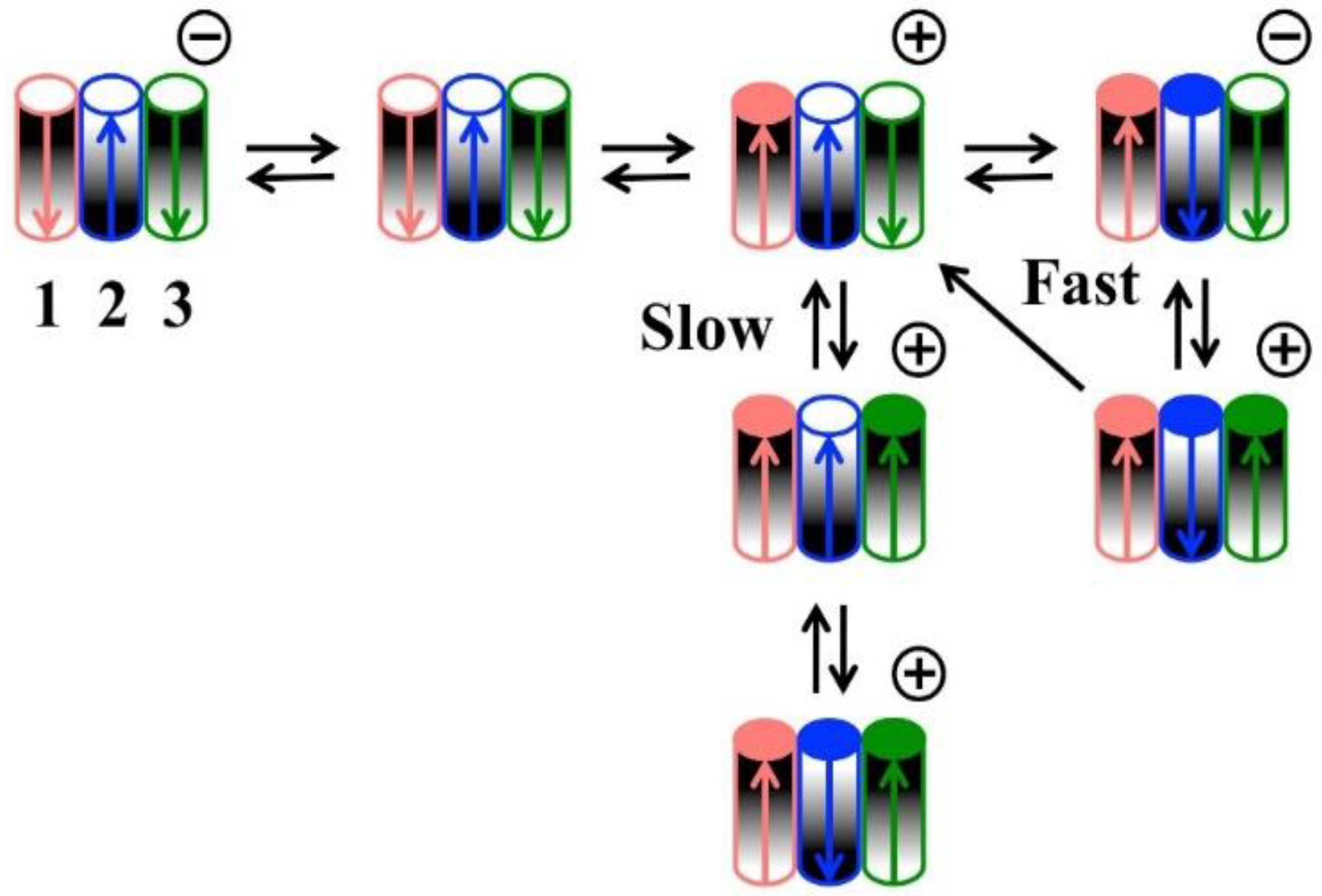
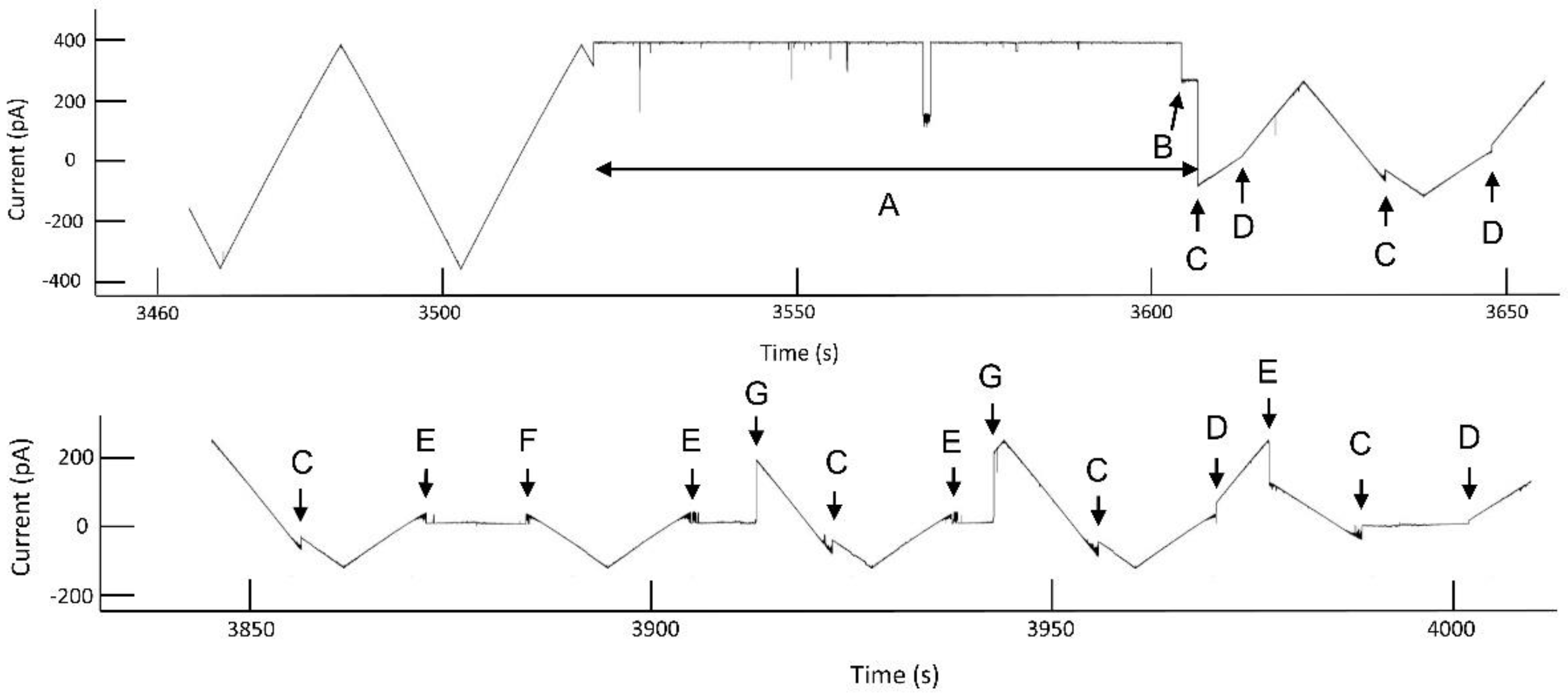

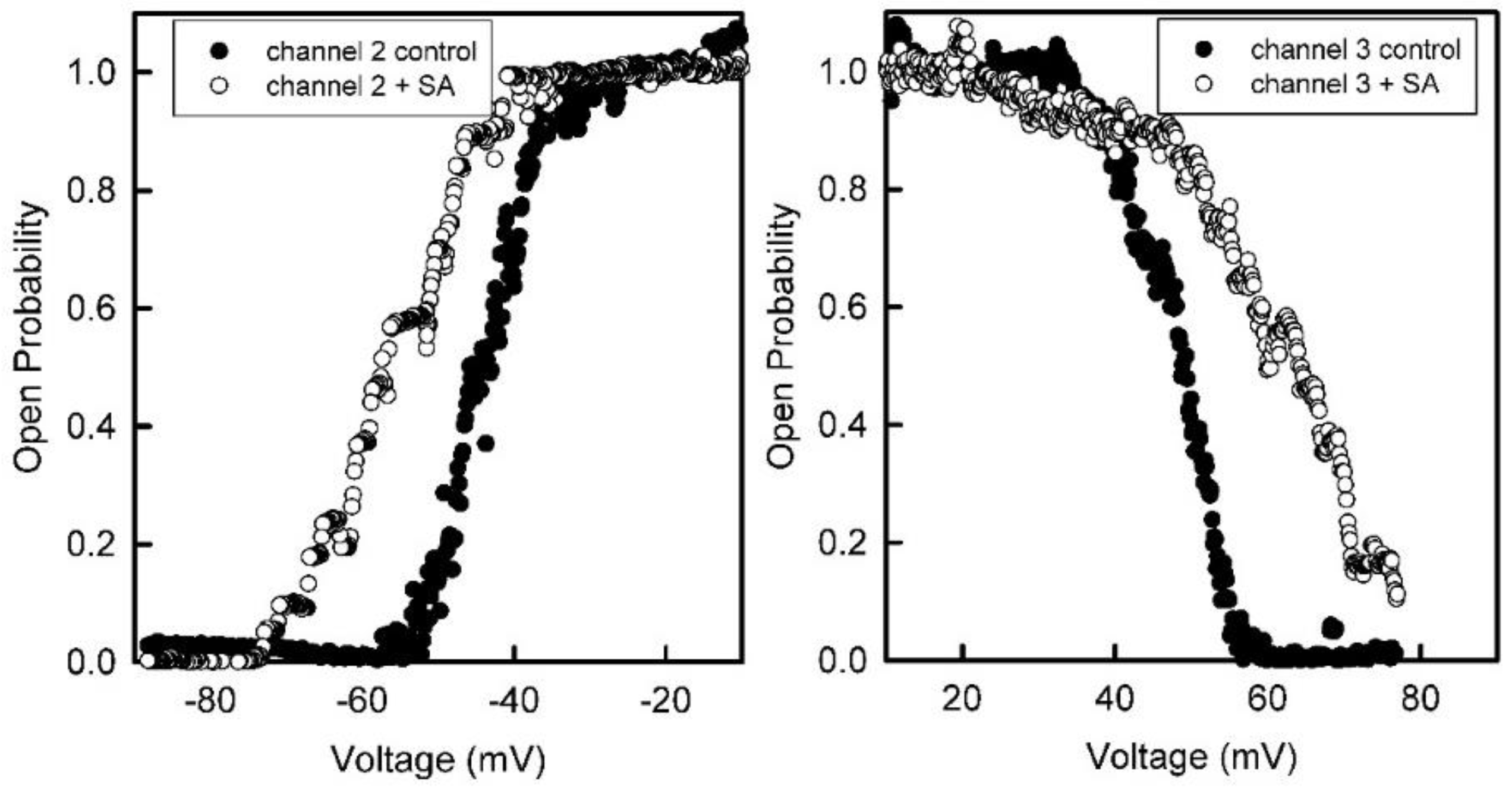
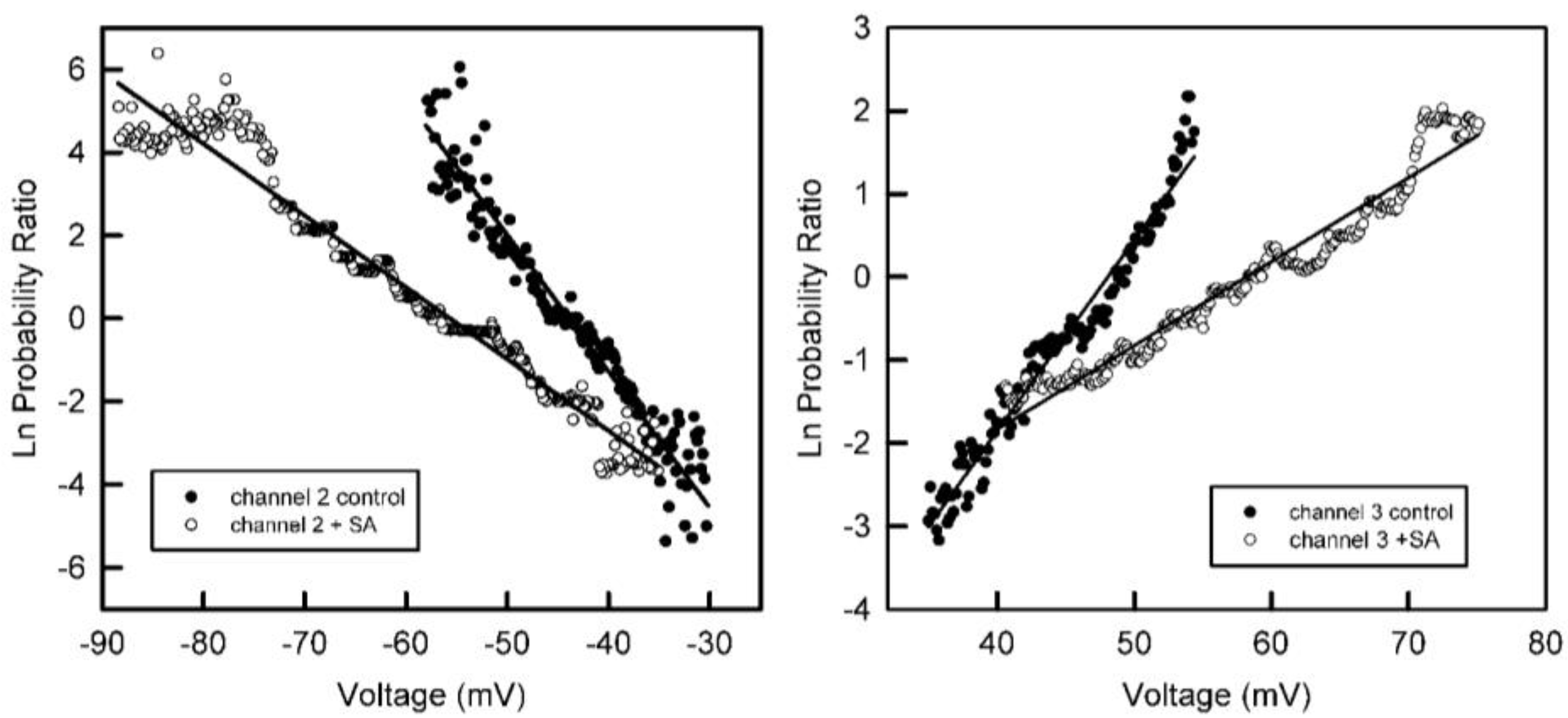
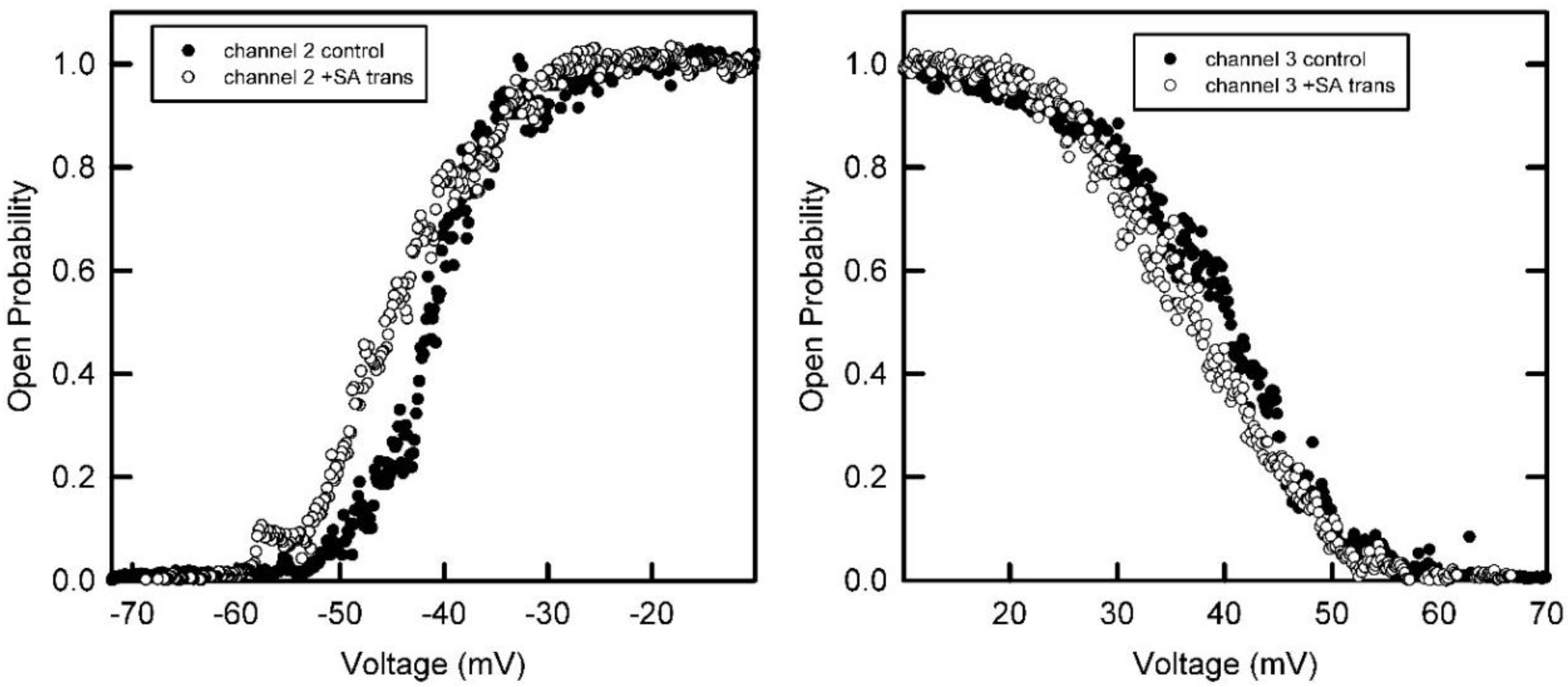
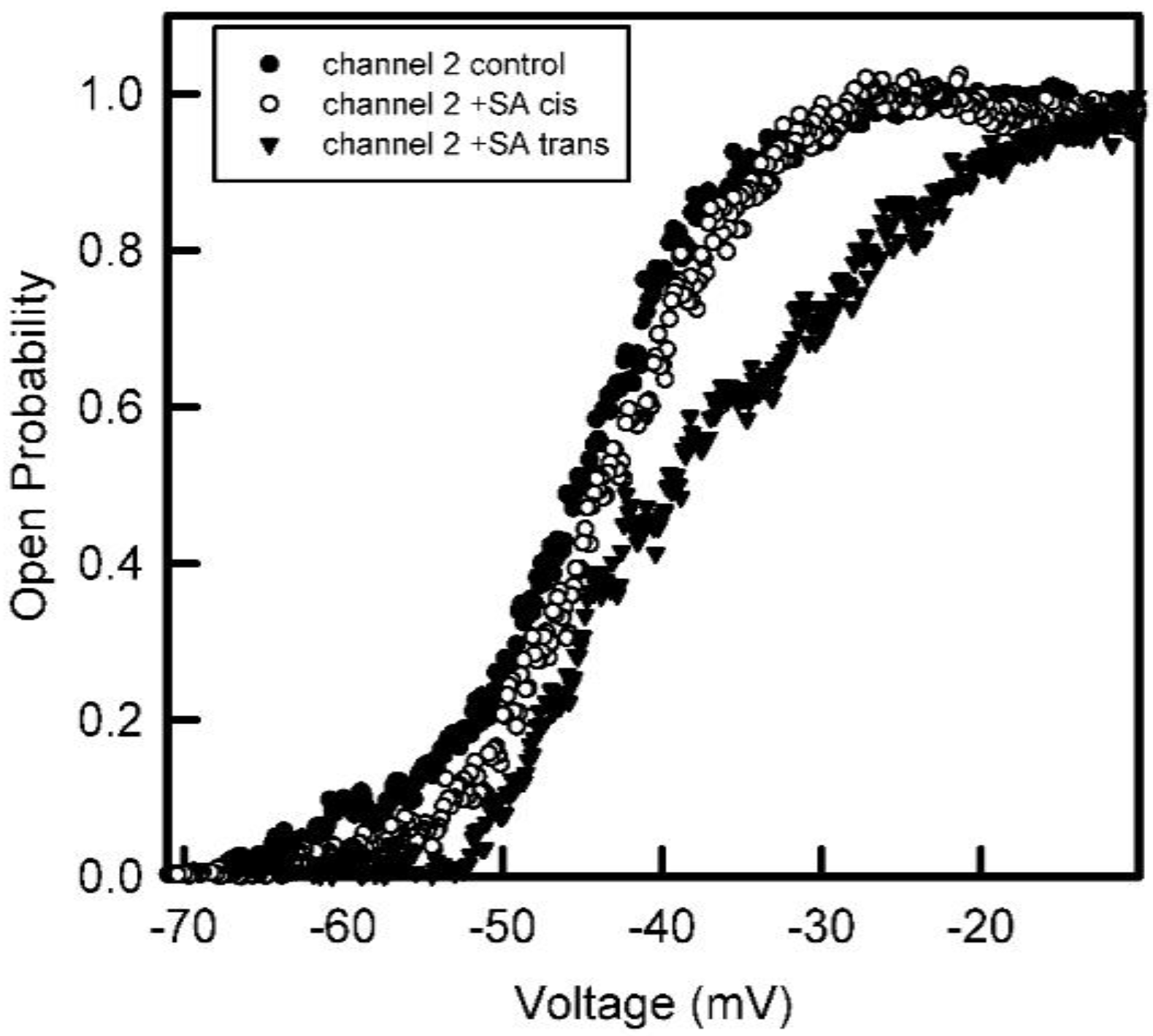




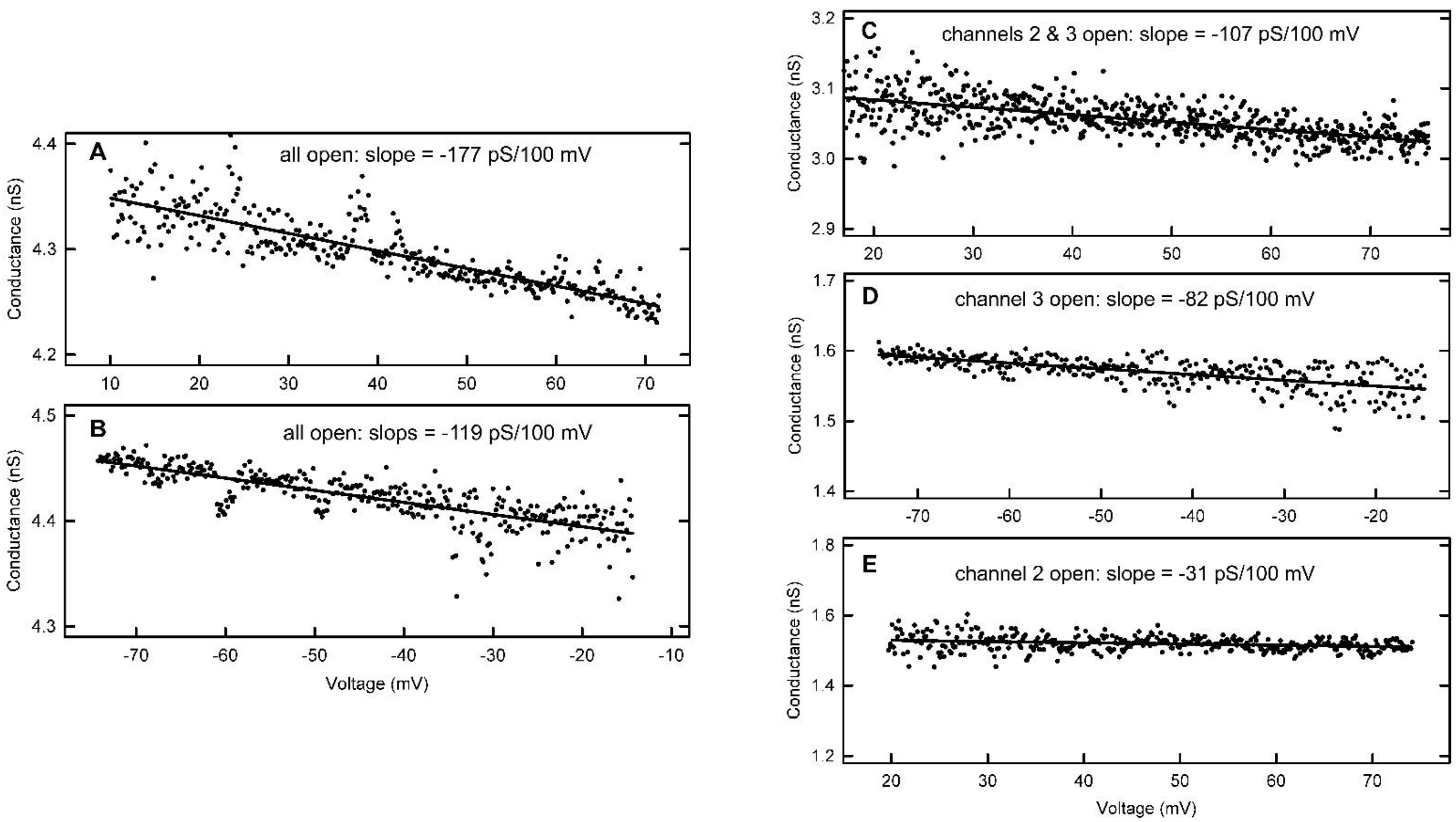
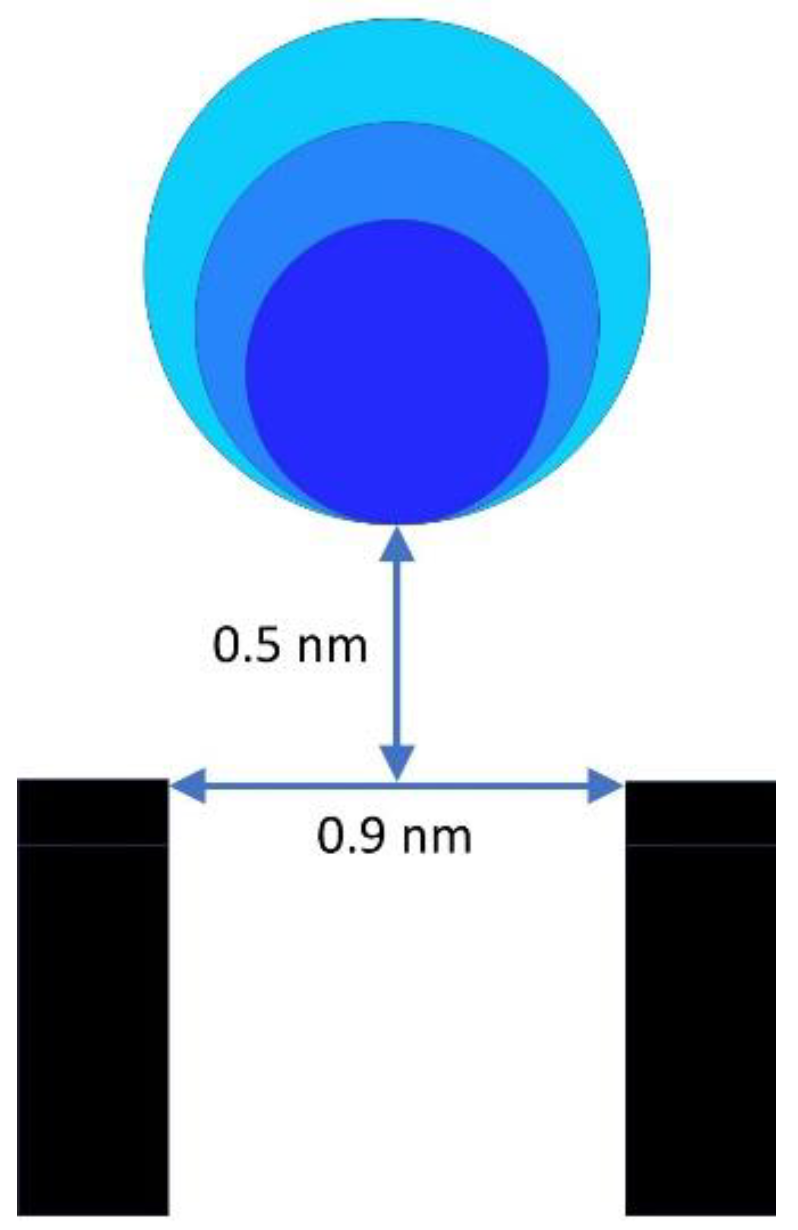
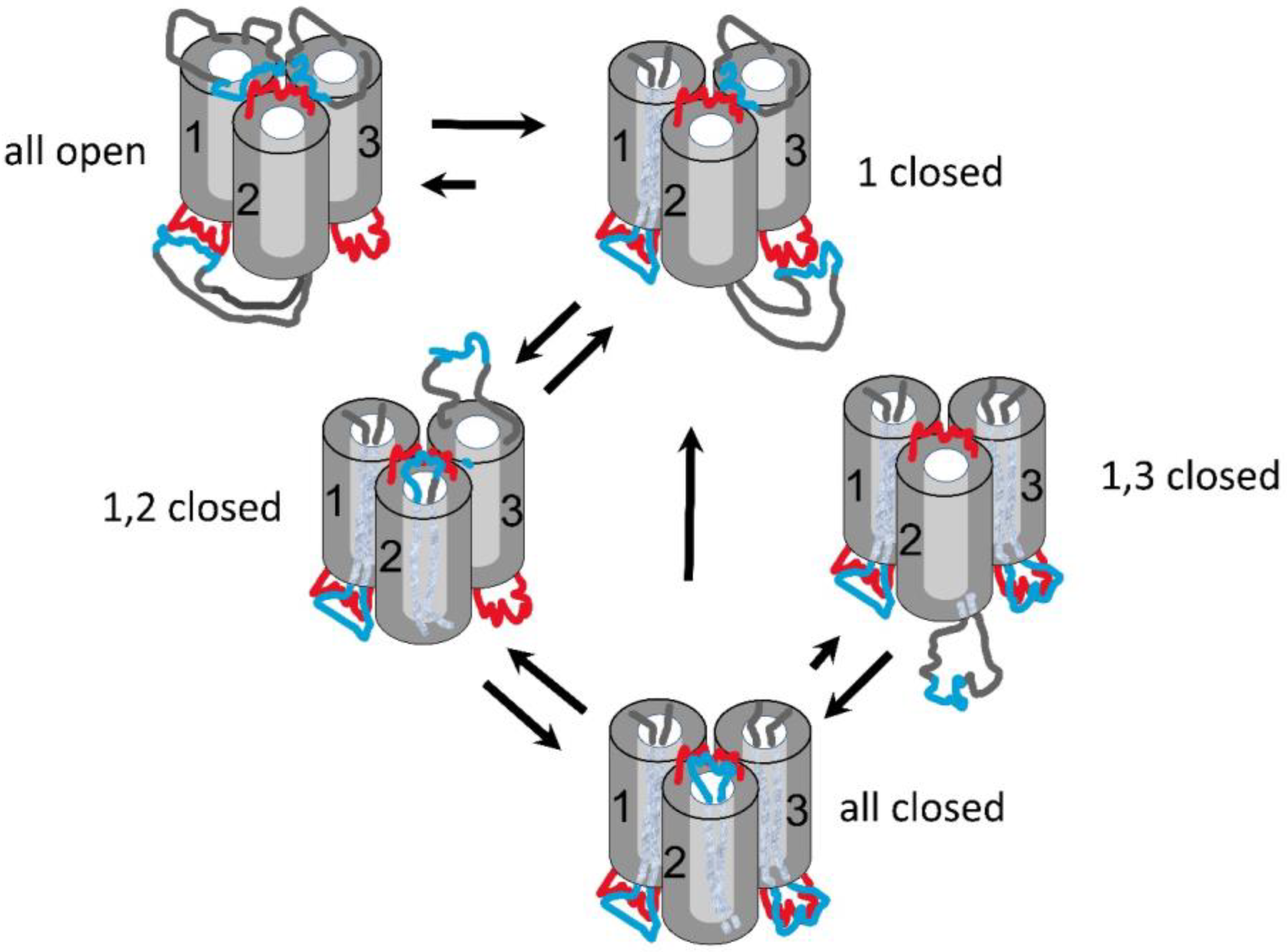

| Open Pore Conductance (nS) (in 1 M KCl) | Selectivity (Pc/Pa) | Pore Size (nm) | Number of Pores | |
|---|---|---|---|---|
| Triplin | 1.5 | 3.6 | 0.9 | 3 |
| OmpC | 1.5 | 26 | 1.0 | 3 |
| OmpF | 2.1 | 3.6 | 1.2 | 3 |
| PhoE | 1.8 | 0.3 | 1.1 | 3 |
| LamB | 2.7/0.2 | 4.5 | 1.4 | 3 |
| Subunit under Study | State of Subunit during S.A. Addition | State of Subunit 2 during S.A. Addition | Side of Membrane to Which S.A. Was Added | % Drop of n | # of Independent Experiments | T-Test p Value |
|---|---|---|---|---|---|---|
| 2 | open | cis | 0.6 ± 4.1 | 7 | 0.43 | |
| 2 | open | trans | 30 ± 5 | 12 | 0.00003 | |
| 2 | closed | cis | 27 ± 6 | 12 | 0.0012 | |
| 2 | closed | trans | −5.1 ± 8.0 | 4 | 0.30 | |
| 3 | open | 2 open | cis | 5.7 ± 6.8 | 6 | 0.21 |
| 3 | open | 2 closed | cis | 43 ± 6 | 10 | 0.00015 |
| 3 | open | 2 open | trans | 2.1 ± 4.4 | 7 | 0.29 |
| 3 | open | 2 closed | trans | −7 ± 6 | 5 | 0.14 |
| 3 | closed | cis | 8.5 | 1 | ||
| 3 | closed | trans | 49 | 2 |
| Subunits Open | Voltage Range | G/V (pS/100 mV) | Number of Experiments |
|---|---|---|---|
| 1, 2, 3 | positive | −176 ± 2 | 8 |
| 1, 2, 3 | negative | +112 ± 4 | 9 |
| 2, 3 | positive | −106 ± 4 | 11 |
| 2 | positive | −36 ± 6 | 8 |
| 3 | negative | +75 ± 4 | 11 |
| Subunit Open | Voltage Range | G/V (pS/100 mV) | Method Used |
|---|---|---|---|
| 1 | positive | −70 | Subtracting (1 + 2 + 3) − (2 + 3) |
| 1 | negative | +75 | Assuming rectification of 1 and 3 are the same for V < 0 |
| 2 | positive | −36 | From measurements |
| 2 | negative | −38 | Assuming rectification of 1 and 3 are the same and subtracting (1 + 2 + 3) − 2(3) |
| 3 | positive | −70 | Subtracting (2 + 3) − (3) |
| 3 | negative | +75 | From measurements |
| Subunits Open | Voltage Range | Measured G/V (pS/100 mV) | Expected G/V If No Charge Asymmetry | Rectification Due to Charge Asymmetry (pS/100 mV) |
|---|---|---|---|---|
| 1, 2, 3 | positive | −176 | −111 | −65 (−32 per sensor) |
| 1, 2, 3 | negative | +112 | −111 | +223 (+112 per sensor) |
| 2, 3 | positive | −106 | −74 | −32 (−32 per sensor) |
| 2 | positive | −36 | −37 | +1 |
| 3 | negative | +75 | −37 | +112 (+112 per sensor) |
Publisher’s Note: MDPI stays neutral with regard to jurisdictional claims in published maps and institutional affiliations. |
© 2022 by the authors. Licensee MDPI, Basel, Switzerland. This article is an open access article distributed under the terms and conditions of the Creative Commons Attribution (CC BY) license (https://creativecommons.org/licenses/by/4.0/).
Share and Cite
Colombini, M.; Barnes, K.; Chang, K.-T.; Younis, M.H.; Aguilella, V.M. Triplin: Functional Probing of Its Structure and the Dynamics of the Voltage-Gating Process. Int. J. Mol. Sci. 2022, 23, 13765. https://doi.org/10.3390/ijms232213765
Colombini M, Barnes K, Chang K-T, Younis MH, Aguilella VM. Triplin: Functional Probing of Its Structure and the Dynamics of the Voltage-Gating Process. International Journal of Molecular Sciences. 2022; 23(22):13765. https://doi.org/10.3390/ijms232213765
Chicago/Turabian StyleColombini, Marco, Kevin Barnes, Kai-Ti Chang, Muhsin H. Younis, and Vicente M. Aguilella. 2022. "Triplin: Functional Probing of Its Structure and the Dynamics of the Voltage-Gating Process" International Journal of Molecular Sciences 23, no. 22: 13765. https://doi.org/10.3390/ijms232213765
APA StyleColombini, M., Barnes, K., Chang, K.-T., Younis, M. H., & Aguilella, V. M. (2022). Triplin: Functional Probing of Its Structure and the Dynamics of the Voltage-Gating Process. International Journal of Molecular Sciences, 23(22), 13765. https://doi.org/10.3390/ijms232213765








